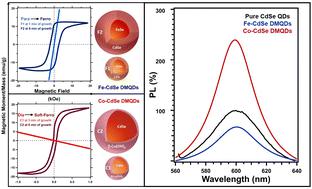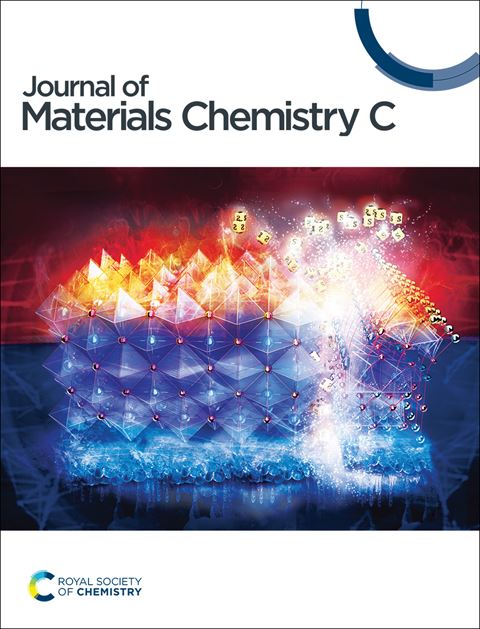The interplay between magnetism and structure in Co/Fe-CdSe diluted magnetic quantum dots
IF 5.7
2区 材料科学
Q2 MATERIALS SCIENCE, MULTIDISCIPLINARY
引用次数: 0
Abstract
Magnetic dopants are commonly employed to modify the characteristics of dilute magnetic quantum dots (DMQDs), resulting in a significant alteration in their magnetic ground state. A thorough investigation of the structural changes induced by the dopants during DMQD growth is pivotal to comprehending the magnetic state of the system. In this regard, we employed the well-established organometallic route to manufacture CdSe QDs with trace amounts of Co and Fe, and we halted their growth process at two different stages. Subsequently, we utilized high-resolution transmission electron microscopy, X-ray diffraction, X-ray photoelectron spectroscopy, photoluminescence, and vibrating sample magnetometry to examine the interplay between each structure and its magnetic properties. Our analyses reveal that Co ions form a β-Co(OH)2 shell on the surface of the CdSe QD, changing the diamagnetism of the pure CdSe matrix into soft-ferromagnetism of the DMQD at a low magnetic field, accompanied by a substantial enhancement in photoluminescence, amounting to approximately 250% in comparison to the pure CdSe QDs. In contrast, Fe ions form a FeSe structure in the core of the CdSe QD, leading to a room-temperature ferromagnetic DMQD. Both DMQDs are potential candidates for quantum information storage and processing, enabling the development of advanced quantum technologies.

Co/Fe-CdSe 稀释磁性量子点中磁性与结构之间的相互作用
磁性掺杂剂通常用于改变稀释磁性量子点(DMQDs)的特性,从而显著改变其磁性基态。深入研究掺杂剂在 DMQD 生长过程中引起的结构变化,对于理解系统的磁性状态至关重要。为此,我们采用了成熟的有机金属路线来制造含有痕量钴和铁的碲化镉 QDs,并在两个不同阶段停止了它们的生长过程。随后,我们利用高分辨率透射电子显微镜、X 射线衍射、X 射线光电子能谱、光致发光和振动样品磁力计来研究每种结构与其磁性之间的相互作用。我们的分析表明,钴离子在硒化镉 QD 表面形成了β-Co(OH)2 壳,在低磁场下将纯硒化镉基体的二磁性转变为 DMQD 的软铁磁性,同时光致发光也大幅增强,与纯硒化镉 QD 相比增强了约 250%。相反,铁离子在 CdSe QD 的核心形成了 FeSe 结构,从而产生了室温铁磁 DMQD。这两种 DMQD 都是量子信息存储和处理的潜在候选材料,可促进先进量子技术的发展。
本文章由计算机程序翻译,如有差异,请以英文原文为准。
求助全文
约1分钟内获得全文
求助全文
来源期刊

Journal of Materials Chemistry C
MATERIALS SCIENCE, MULTIDISCIPLINARY-PHYSICS, APPLIED
CiteScore
10.80
自引率
6.20%
发文量
1468
期刊介绍:
The Journal of Materials Chemistry is divided into three distinct sections, A, B, and C, each catering to specific applications of the materials under study:
Journal of Materials Chemistry A focuses primarily on materials intended for applications in energy and sustainability.
Journal of Materials Chemistry B specializes in materials designed for applications in biology and medicine.
Journal of Materials Chemistry C is dedicated to materials suitable for applications in optical, magnetic, and electronic devices.
Example topic areas within the scope of Journal of Materials Chemistry C are listed below. This list is neither exhaustive nor exclusive.
Bioelectronics
Conductors
Detectors
Dielectrics
Displays
Ferroelectrics
Lasers
LEDs
Lighting
Liquid crystals
Memory
Metamaterials
Multiferroics
Photonics
Photovoltaics
Semiconductors
Sensors
Single molecule conductors
Spintronics
Superconductors
Thermoelectrics
Topological insulators
Transistors
 求助内容:
求助内容: 应助结果提醒方式:
应助结果提醒方式:


